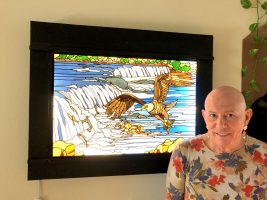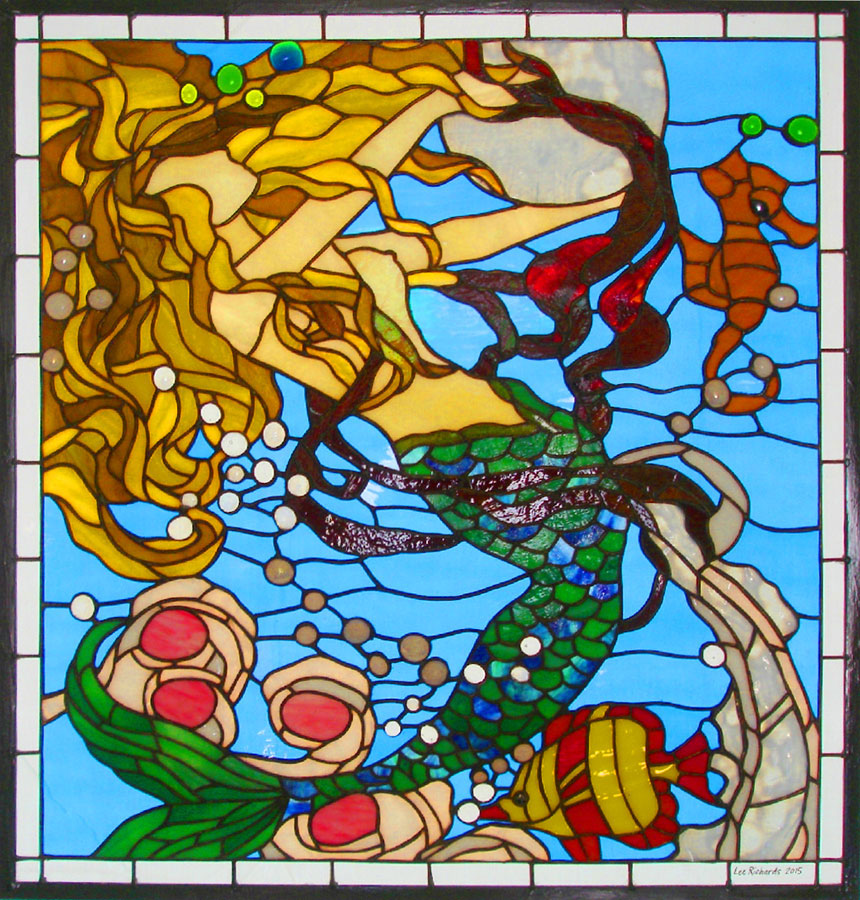
When stained-glass artist Lee Richards posted an image of his “Peacock” on a website dedicated to stained glass professionals, the proverbial guano hit the fan.
“I was accused of faking it,” Richards says in his Matanzas Woods home studio, amid slabs of exotically colored glass, various saws, cutters and grinders, and a big stash of Band-Aids – after all, the glass he slices sometimes slices back.
“ ‘Peacock’ is one of my works I’m most proud of,” says Richards, who is the Gargiulo Art Foundation’s reigning Flagler County Artist of the Year. “Because the pieces were so small and difficult to cut, they thought I painted it.”
While Richards’ fellow stained-glass artists were gobsmacked by the complexities and intricacies of his work, the traditional art world – painters and the galleries that hawk their work, or, at least, the more snobby ones — had tossed flak toward Richards from the other end of the spectrum.
“I’ve taken my work around to galleries, like at St. Augustine, and I was told point-blank, ‘We don’t take stained glass – that’s crafts, we’re fine arts,’ ” Richards says. “That has happened more often than not.”
Such encounters might make one think of Richards as the Rodney Dangerfield of the local art world – that he doesn’t get any respect. But the Gargiulo Art Foundation reversed that fate for the architect and engineer, naming him its 2019 Flagler County Artist of the Year last November.
Normally Richards would be half way through his reign and its attendant activities, including a celebratory one-man show of his artwork. However, the abrupt late-2019 closing of the Berkshire Hathaway realty office and its art gallery, housed at European Village in Palm Coast, meant the postponement of the Richards exhibition scheduled there in January. A rescheduled exhibit set for May at Grand Living Gallery in Palm Coast was scuttled by the pandemic.
“This is the first time we’ve honored a stained-glass artist,” says Tom Gargiulo, who co-founded the foundation with his partner Arlene Volpe. Richards is the GAF’s twentieth artist of the year since Peter Cerreta became the first to be so honored in 2000.
Gargiulo recalls talking with Richards after the foundation presented an artists panel discussion open to the public: “He’s an architect. He considers architecture left-brain. Engineering – left-brain. I said, ‘Lee, I disagree with you – architecture and engineering, that’s doing creative stuff.’ We got to talking about that. Then you realize he’s a very creative guy who’s been doing this stained-glass fine art for 40 years to keep actively creating because he felt he wasn’t creative enough as an architect.”
That left-brain/right-brain dichotomy speaks to the heart of stained-glass artistry, Richards says. The left hemisphere of the human brain, some theories suggest, governs what is rational, analytical and mathematical in our thought, while the right hemisphere is home to the intuitive, mystical and artistic. Some observers have tied the left-brain/right brain paradigm to what the ancient Greeks and even Nietzsche called the Apollonian/Dionysian dichotomy: the former embodies order and reason, the latter all that is emotive, irrational and even orgiastic.
“I like to think that stained glass is a left-brain/right-brain kind of mechanical system,” Richards says. “You have to come up with the idea. You have to design it. But glass is unique in the sense that when you design it, there are certain things that you have to do. You have to have structural stability. If you don’t, the weight of it will pull it down, and it pulls the foil (which acts as solder between pieces) right off of it.
“The design has a lot of geometry to it and a lot of structural physics to it. So, it’s a perfect blend of art and construction and how things come together. It was a perfect art medium for me.”
His maps in Vietnam helped generals to get the lay of the land and sniff out the Viet Cong.
Growing up in Baltimore, Richards loved to draw but he had no formal art training. He continued to create “hundreds of pen drawings” while serving as a cartographer for the Army during the Vietnam War, where his maps helped generals to literally get the lay of the land to sniff out the Viet Cong. Richards earned a bachelor’s degree in chemistry from Coppin State, a master’s degree in architecture from Morgan State, and a doctorate in engineering management, via online “distant learning” from the now-defunct Kennedy-Western University.
He settled into a two-decade career as an architect in the Baltimore area, then landed facilities management posts at Morgan State, the University of Alaska system, Embry-Riddle Aeronautical University in Daytona Beach, and Tulane University. (Though Kennedy-Western was unaccredited “because in those days they said you had to go to a campus,” Richard says, he notes that all those university systems “accepted my his 270-page doctoral thesis when they saw my work.”)
As Richards designed Blockbuster video stores, commercial buildings and residential homes, his second wife suggested that he “needed a way to blow off steam,” he says. So, in his mid-30s, he enrolled in a beginner’s stained-glass class.
He was hooked when he quickly discovered that stained glass, akin to architecture, “is so left-brain and right-brain – that’s why I love it so much.” Even as he was learning techniques in that class, Richards’ architectural and engineering weltanschauung was goading him to take stained glass further.
That class taught him a process that used extruded lead, “but the problem is that you can’t curve that stuff to get the kind of profiles of pieces that I wanted to do,” he says. “Extruded lead is for a very simple kind of scene.” The switch to a process that utilizes thin strips of copper foil as solder gave him the capability to pursue the extravagant designs that his muse was teasing him with.
“I have stretched what can and can’t be done with stained glass — I think to the limit,” Richards says. “And that was my goal. I wanted to take it as far as it could possibly go with respect to physical construction. Religious windows – people look at that and they think each little thing is its own piece of glass. Well that’s not true. If you look at it closely enough, there are great big pieces of glass that have been painted. It’s the painting skill that I don’t really have. I could learn it because it’s taught, but I don’t want to do that. I much more enjoy using the pieces of glass themselves as the artwork. That’s my palette.”
While the occasional dragon or mermaid appears in his work, Richards prefers landscapes, wildlife and erotica – the latter featuring tasteful but alluring female figures. Some of his works in his home are hung in front of windows: “You look at them with the sun coming through, they just come alive,” he says. Other works are mounted on light boxes he has fashioned from balsa wood.

“People who saw ‘Peacock’ online said it wasn’t real,” Richards says. “They couldn’t believe I was able to cut pieces that small. There are very few stained-glass artists who can cut that.”
Stained glass, he says, is “an art medium that works against you.”
While he works from patterns he has drawn of his subjects, “You don’t know what it’s going to look like until it’s finished.” he says. “Then it’s obviously too late. There have been pieces that I looked at and I didn’t have an ‘a-ha’ moment — I had an ‘Oh shit’ moment because the glass just didn’t come out the way I wanted it to. And, of course, I have a ton of Band-Aids because it’s impossible not to cut yourself when you’re doing this.”
Richards — who in 2008 moved to Palm Coast, where he met his current wife, the Italian-born Gioia — notes he has “won my share of best in show, first and second place awards” in local juried art shows.
“So I can’t complain, I really can’t,” he says. Yet his frustration with such shows –borne of that Rodney Dangerfield no-respect syndrome – surfaces.
“I came to understand it depended on who the judge was,” Richards says. “A judge might know something about stained glass, and realize how incredibly difficult it is to do a piece and how long it took and who considers it a piece of fine art. Sometimes you get a judge who thinks, ‘Oh, my aunt does that in her basement.’ They have no clue. I’ve been fighting that ever since I joined FCAL.”
Along with selecting its artist of the year, the Gargiulo Art Foundation supports the Flagler County art scene by curating and staging art shows as well as lectures, panels, workshops and classes. The foundation also commissions and purchases artworks for public spaces, including the collection at the Flagler/Palm Coast campus of Daytona State College, and the nascent sculpture garden on Palm Coast city property at Town Center.
The GAF seeks the same supportive ethic in choosing its artist of the year.
“We look for artists who are not only doing good art but who are contributing to the community,” Gargiulo says.
Richards amply qualified by contributing massive sweat equity when the Flagler County Art League moved into a larger space within Palm Coast’s City Marketplace during fall 2018.
“Being an architect on the FCAL board, I said, ‘Look, I will take it upon myself to help design this thing and get it built,’ ” Richards says. The new location, just a few hundred yards from FCAL’s then-current home in City Marketplace, was larger and would provide the desired additional area. But, Richards says with his architect’s eye taking over, “It was awful — a terrible space. But you had to have a vision.”
The plan called for Richards to design the space into an arts-friendly environment, and for a hired contractor to do the actual construction. That plan fell through – literally – when the contractor fell through a roof and injured himself on another job. So, with occasional help from FCAL folks, Richards and his stepson Jace, a carpenter, rolled up their sleeves and went to work breaking walls, reconfiguring space and installing drywall, lighting and flooring.
“It was a labor of love,” says Richards, who currently works as an architect and project coordinator for the city of Flagler Beach.
As for being named GAF’s Artist of the Year, “I am unbelievably honored by that,” he says. “This honor says that my art is appreciated and everything I’ve done for the art league has been appreciated.”
![]()

***
cutlines
Richards tests how various pieces of green glass may come together for his latest work, “Iguana on a Branch.” FlaglerLive photo
The finished piece: “Iguana on a Branch.” Image provided by Lee Richards
Lee Richards poses between two of his favorite works – “Peacock” and “La Papagallo” (Spanish for “macaw”). FlaglerLive photo
Oceanna. Image from leerichardsstainedglass.com
Goddess with Flowers. Image from leerichardsstainedglass.com





























Dennis says
Wow, what talent. That is awesome.
Carol Carter says
Lee is a very accomplished and talented artist who is not afraid to explore different avenues of art. I took a class with him and he stood out from his classmates and was very helpful with educating us in how to make our portraits come alive! I look forward to see what next work of art he is creating in that productive mind of his!